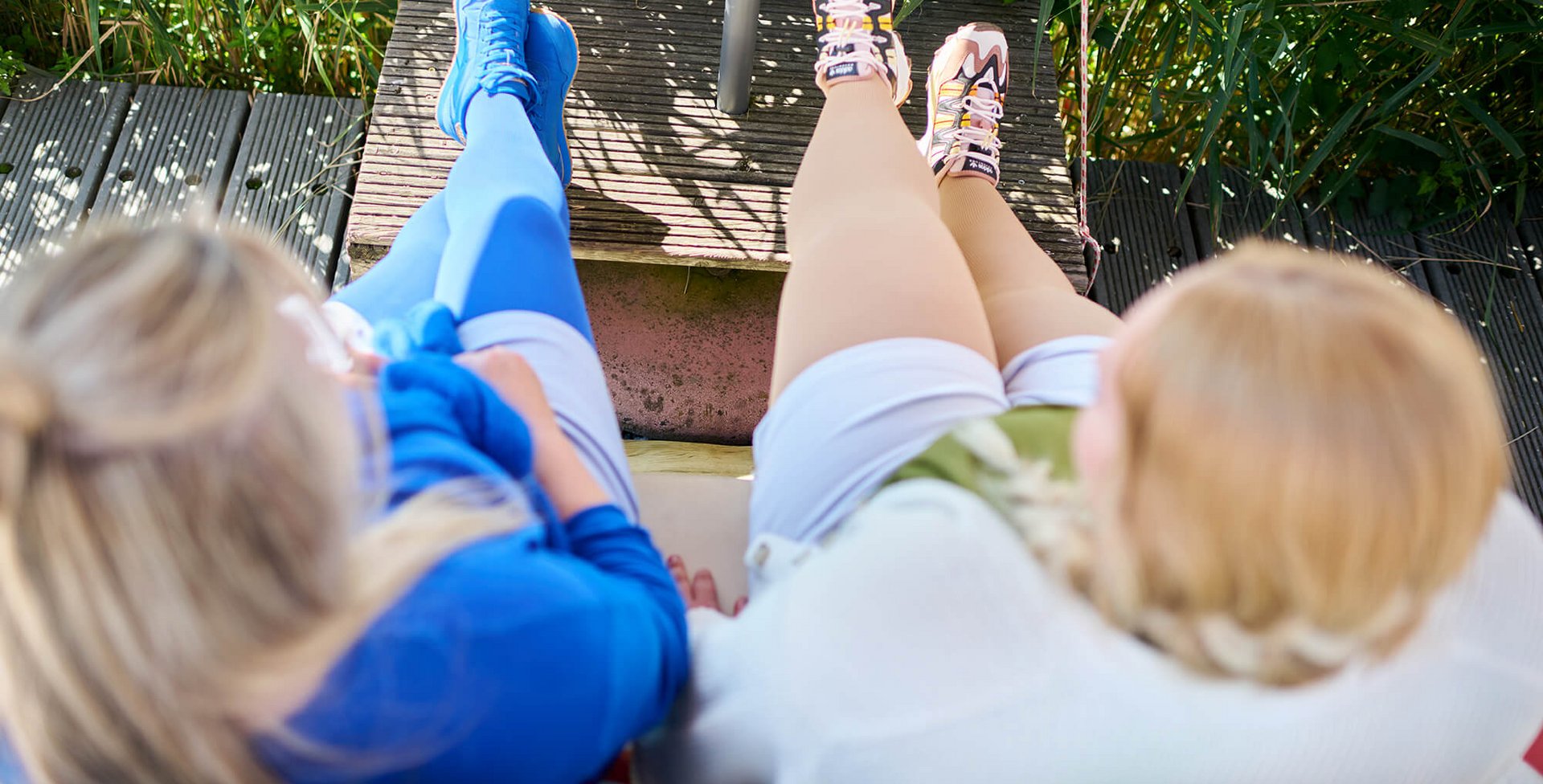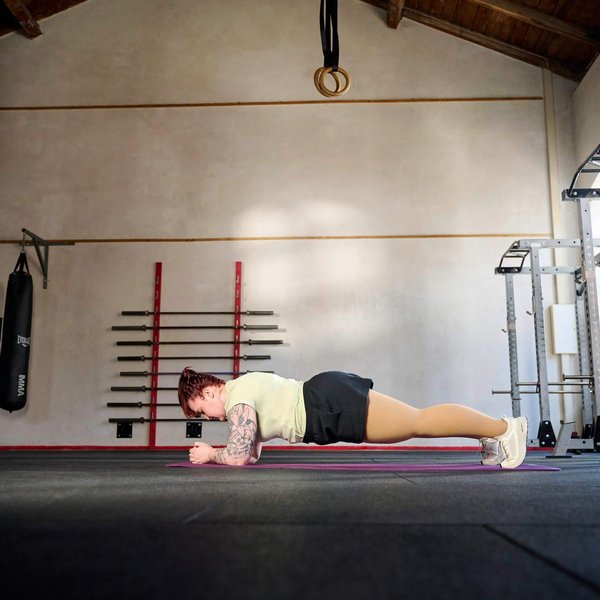
Your active life despite lymphedema
Combat swollen, tired, heavy legs
Do your arms or legs constantly feel swollen and heavy? Are your legs distinctly larger than your upper body and even gentle touches feel painful?
Then you might ask yourself whether lymphedema or lipedema is responsible for your problems. With our lymphedema/lipedema self-test, we would like to help you gain a better understanding of your problems.

HAVE YOU BEEN DIAGNOSED ALREADY? »
Have you recently been diagnosed with lymphedema or lipedema by your physician? Or was it a little while ago perhaps? Then you’re in the right place.
Find out everything about possible treatment options and how you can still live a happy life despite lipedema or lymphedema.

At Bauerfeind, we will not leave you to deal with your condition alone, but we want to give you the support you need.

Comparing lymphedema and lipedema
Everything you need to know about edema
In addition to the cardiovascular system, the lymphatic system is the second important circulatory organ in the body. It drains the area between tissue, and transports waste products created by the metabolism back into the circulatory system via the lymph vessels and lymph nodes. Lymphedema refers to the consequences of a lymphatic drainage disorder. that results in the lymphatic fluid (lymph) pooling in the tissue, and in the development of swelling, usually in the legs. If left untreated, lymphedema will continue to progress and start to change. This may cause complications: the tissue becomes hardened, the skin gets taut, and those affected will be severely restricted in their mobility. This is referred to as a Stage III lymphedema (also known as the now no longer commonly used “elephantiasis”). The edema can then no longer be indented, and the legs look like pillars, corpulent and swollen, sometimes with pronounced skin folds, often covered in flaky, dry skin. In addition, the risk of skin infection will rise. It is therefore crucial to treat the impaired lymphatic drainage.
Lymphedema can develop anywhere in the body, though it is most common in the arms and legs. The onset of the condition can be gradual. You should therefore keep an eye on your body and make a note of any changes.
Possible signs of lymphedema include:
Do some of these symptoms apply to you but you haven’t got a diagnosis from a physician yet? Then our self-test can provide an initial assessment whether you may be suffering from lymphedema.
A distinction is made between primary and secondary lymphedema.
Primary lymphedema is a congenital lymph drainage disorder. If there are not enough lymph vessels or they are too narrow, if vascular walls are too wide, lymph nodes are hardened or missing, lymphedema can be the result. Only one in three patients suffers from this type of lymphedema, which affects the legs in more than 90 per cent of cases. Primary lymphedema can develop on one side as well as on both sides. It is mainly women who are affected – usually already at a young age.
Secondary lymphedema occurs later on in life and is not hereditary. Swelling close to the body’s center is usually the start of the condition, with subsequent spreading to areas further away. A particularly common cause for secondary lymphedema is cancer (especially breast cancer) and treatment associated with it – such as removal of lymph nodes or radiation therapy. However, accidents, inflammation, parasites or injuries can also damage the lymphatic system. In addition, in patients suffering from lipedema, the increased pressure in the legs can have a detrimental effect on the lymph vessels. Many lipedema patients will therefore develop impaired lymphatic drainage sooner or later. In this case, we refer to it as lipedema with secondary lymphedema or a stage IV lipedema.
Lipedema is a painful fat distribution disorder which especially manifests in the thigh and buttock regions. Over many years suffering from this condition, the legs can increasingly lose shape and develop fat deposits. It almost exclusively affects women.
The unbalanced physical proportions stand out particularly when women with normal upper bodies have very wide buttocks and excessively large thighs. However, during the initial stage in particular, a distinction between lipedema and obesity, i.e. pathological excess weight, can be difficult. Lipedema presents with painful fatty tissue, which is not the case with obesity. That’s why lipedema is also known as lipohyperplasia dolorosa: increased, painful fatty tissue.
Noticeable proportions are an important symptom, but are often disregarded as simply being overweight. But in order to exclude a chronic condition, such as lipedema, it’s important to be sure. The following questions can help:
Women who can – or rather must – answer several of these questions with “yes”, should consult their physician or a specialist, such as a lymphologist, phlebologist, or dermatologist.
Changes occurring symmetrically are typical for lipedema: both legs are affected to the same extent. A lot of the time, the thighs and hips, as well as frequently buttocks and lower legs, feature these bulky fatty deposits. It’s noticeable that the feet are not affected, which is why overlapping folds can occur in the ankle region during later stages. Skin and tissue are extremely painful and sensitive to impact, with the skin feeling cold. Lipedema in the arms is more rare.
As mentioned above, lymphedema is a lymph drainage disorder. It causes intense and painful swelling, commonly in the arms or legs. Lipedema, on the other hand, is a painful fat distribution disorder that almost exclusively occurs in women. This condition mainly affects the thighs, hips, buttocks and arms. While exercise and a healthy diet will cause the upper body to get slimmer, the arms and legs will remain unchanged. The patient’s proportions become increasingly uneven over time. Specific hormonal phases, such as puberty or pregnancy, usually lead to a significant increase in the development of fat deposits.
| Lymphedema | Lipedema |
| Swelling caused by lymphatic fluid is asymmetrical. | Increase of fat tissue is symmetrical. |
| Pressure and touch are usually not painful. | Pressure and touch are painful. |
| Hands and feet can be affected. | Hands and feet are free from swelling. |
| Bruises occur to a normal extent. | Bruises occur to an unusual extent. |
| Even during initial stages, the skin is prone to inflammation, leading to erysipelas in the worst cases. | Inflammation and skin irritation are rare but may occur when compression garments are worn. |
What can help in cases of lymphedema? Complex decongestive therapy (CDT) is the most effective method for treating lymphedema. It consists of two phases and is based on five pillars.
The phases of CDT:
Phase 1 – decongestion: Daily manual lymphatic drainage and lymphological compression bandages help to decongest the affected limbs and reduce their circumference. This phase usually takes several weeks. Only when the maximum reduction of the circumference in the affected body regions has been achieved can the maintenance phase begin.
Phase 2 – maintenance: The objective is to maintain the outcome of the decongestion phase. The measures required for this (in accordance with the five pillars of CDT) are applied for the patient’s whole life. The curaflow app developed by us helps and motivates those affected. During the maintenance phase, the compression bandage is replaced with a medical compression stocking or sleeve.
The five pillars of CDT:
Lipedema is a chronic, sometimes progressing condition and can therefore not be cured. That’s why lipedema treatment has to cover a wide spectrum to achieve a reduction in swelling and pain so quality of life can be improved for patients.
This also includes complex decongestive therapy as basic treatment:
If left untreated, lipedema will continue to progress. Accompanying obesity will cause the leg circumference to increase constantly, ultimately leading to additional fluid retention. While the lymphatic system can continue to work normally in the first few years, the growing pressure in the leg will have a detrimental effect on the lymph vessels.
This will increasingly affect lymph flow. That is why many patients who suffer from untreated lipedema will also develop impaired lymphatic drainage, or lymphedema, sooner or later. This is referred to as “lipolymphedema” or a stage IV lipedema.
The transition from lipedema to lipolymphedema cannot be definitively identified by leg circumference or water accumulation. Stemmer’s sign is better suited: in this method, the skin on top of the second toe is lifted up or pinched. In cases of pure lipedema, the feet aren’t affected, so this “pinching” is possible until lymphedema develops. Only when the lymphatic fluid can no longer drain properly, will the skin on the toes also be under such tension that it can’t be lifted up. Stemmer’s sign is therefore an important element of the diagnosis. It highlights which treatment options are suitable and which aren’t.
For lipolymphedema, too, complex decongestive therapy is used for treatment.
FIND OUT EVEN MORE ABOUT LYMPHEDEMA OR LIPEDEMA

Let’s go: the right exercise for lymphedema
Card subtitle
How movement, targeted exercises and compression can help with edema

Self-Management with Lipedema and Lymphedema: Laura Takes Charge
Card subtitle
Why chronic conditions like lipedema or lymphedema doesn't have to stand in the way of self-fulfillment
Your compression therapy
Maximum comfort. Maximum quality of life.
Continuous wearing of compression products is a critical component of complex decongestive therapy. That is why we only use high-quality, gentle materials for our products that will make wearing them every day as pleasant as possible. Once you have been prescribed a compression product by your physician, and your medical retailer has advised you and taken your measurements, your product will be custom-made for you. The curaflow app will then provide you with many useful tips about your compression garment.
Whether you need a product for your leg, arm or thorax, the VenoTrain curaflow will ensure noticeable relief and shaping of the body region affected by lymphedema, lipedema or lipo-lymphedema. It reduces painful tension, supports ideal lymph transport with its smart longitudinal structure and counteracts further accumulations. Smooth microfibers make donning easier, the breathable knitted fabric increases wearing comfort, and the extra soft popliteal area and arm zones offer uninhibited mobility. At Bauerfeind, we want you to live an active life.
Discover our products:
RETAILER SEARCH
Get advice on site!
Find a suitable retailer near you.

Bauerfeind.
My treatment for
lipedema and lymphedema
lipedema and lymphedema
Get active! Determing your lymphedema risk



